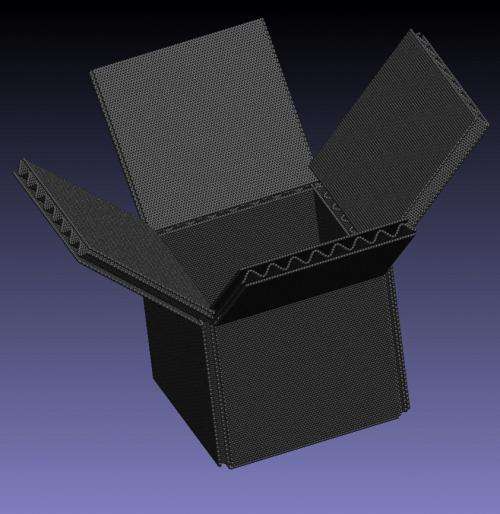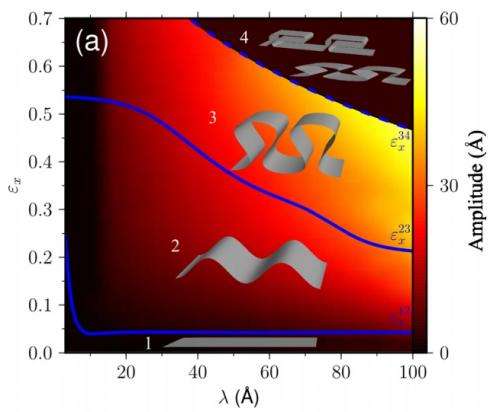March 21, 2014 feature
Proposed graphene cardboard has highly tunable properties

(Phys.org) —Carbon nanomaterials come in many different forms, such as diamond, aerogels, graphene, and soot. Sometimes carbon nanomaterials are even used as building blocks for making more complex nanomaterials. One recent example of this is nanotube forests that are grown to provide the raw material to make nanotube yarns that are woven into custom-made artificial muscles. In short, carbon nanomaterials are a versatile group that seem to provide endless opportunity for innovation.
In a new paper, physicist Pekka Koskinen at the University of Jyväskylä in Finland has proposed and modeled a new composite carbon nanostructure that consists of a rippled graphene sheet sandwiched between two flat graphene sheets, resulting in "graphene cardboard." The work is published in a recent issue of Applied Physics Letters.
"If realized experimentally, the structure could be used as a general-purpose platform at nanoscale, imitating the use of normal cardboard at macroscale," Koskinen told Phys.org. "Cardboard could be also used in the same applications as other porous carbon materials, such as in batteries or in filtering. However, more suitable would be applications that make use of the tunable mechanical properties. With scalable fabrication techniques, the tunability could perhaps even be transferred to macroscale objects made of graphene cardboard."
The idea of graphene cardboard builds on recent experiments that demonstrated periodic rippling in graphene, similar to the rippling of satin sheets. However, experimentally realizing graphene cardboard is likely to be more difficult because the rippled sheet must be sandwiched by outer sheets. The cardboard would be held together by covalent bonds, which could be introduced by either electron irradiation or chemical functionalization.
Although fabricating graphene cardboard may be extremely difficult, in the current paper Koskinen's modeling of the nanocomposite material provides insight into its structural and mechanical characteristics. He found that increasing the shear stress on the cardboard material reveals four phases, starting with flat, to sine-type ripples, to mushroom-type ripples, to collapsed ripples.

Perhaps more interestingly for practical purposes, Koskinen's modeling reveals that graphene cardboard's mechanical properties are highly tunable by modifying the structural deformations, such as compression, shear, and tension. For example, the material's elasticity can be tuned by orders of magnitude by controlling the strain.
For another example, controlling the strain can also theoretically tune the Poisson ratio over a very wide range (-0.5 to 10). The Poisson ratio measures how much a compressed material expands perpendicular to the direction of compression, and is a useful metric for developing new materials. The modeling here shows that the Poisson ratio of graphene cardboard decreases as the strain increases.
"For me the most fascinating result was that even such a simple and natural structure could possibly show negative Poisson ratios," Koskinen said.
Koskinen hopes that these predictions will serve as a motivation for experimentally realizing graphene cardboard. Because the results are general, they can also serve as a starting point for investigating other layered materials with sandwiched rippled structures.
"There are many other atomically thin and flimsy two-dimensional materials, and thus plenty of room to search for novel nanomaterials with customizable properties," Koskinen said.
More information: Pekka Koskinen. "Graphene cardboard: From ripples to tunable metamaterial." Applied Physics Letters. DOI: 10.1063/1.4868125
Journal information: Applied Physics Letters
© 2014 Phys.org. All rights reserved.



















